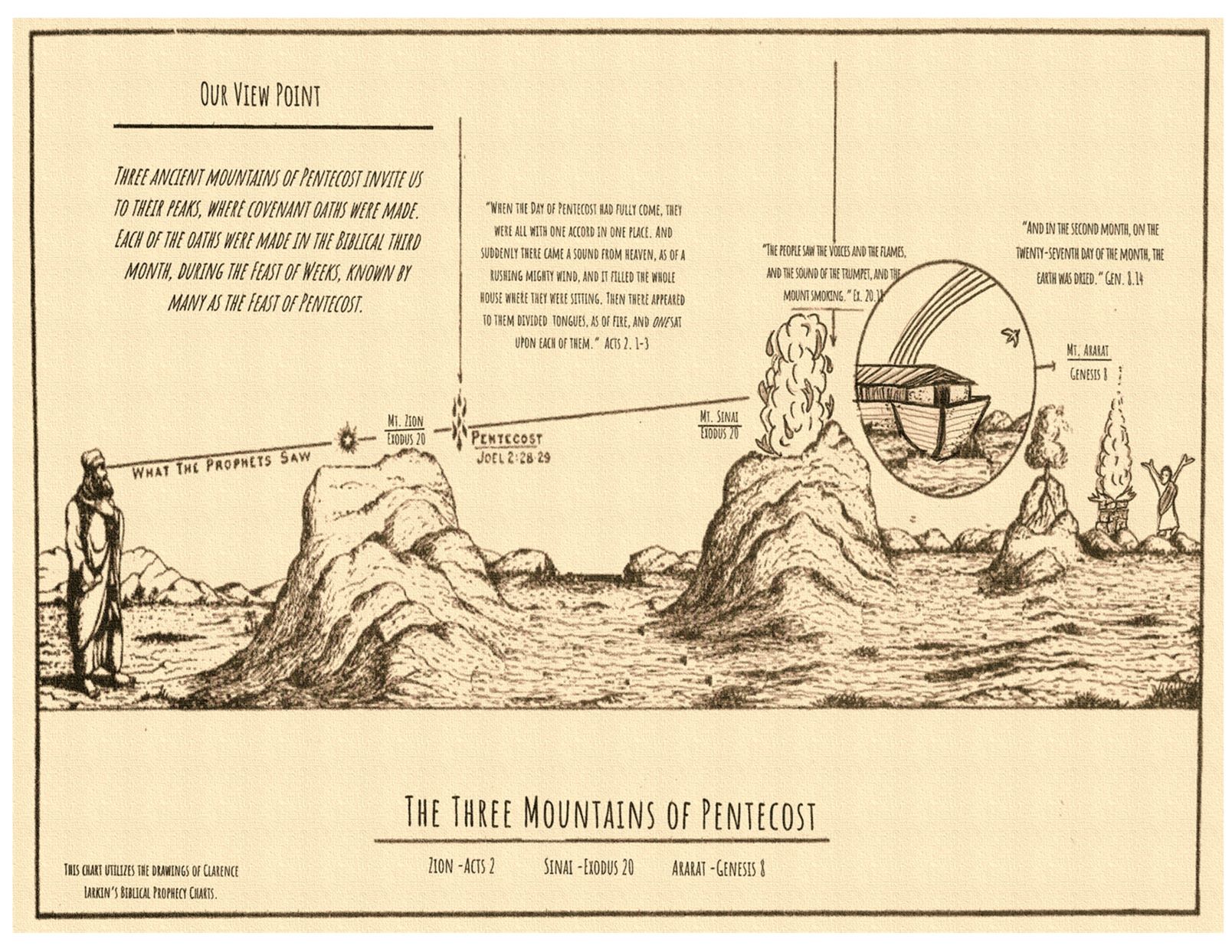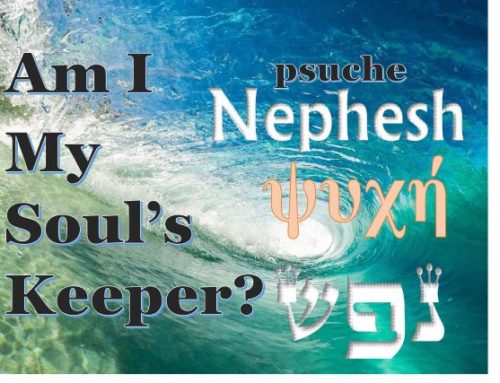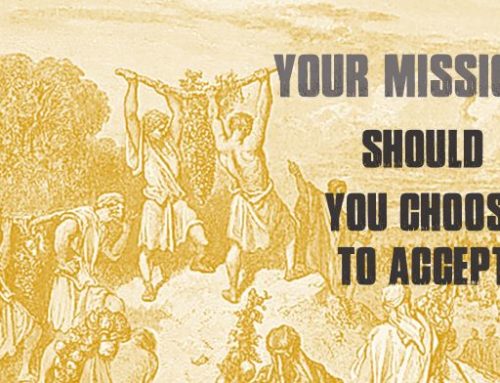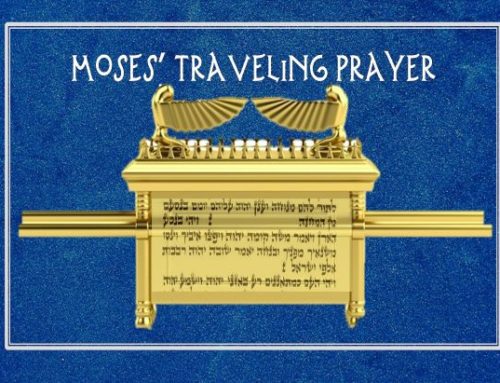Torah Portion, Yitro, Exodus 18.1-20.26, Haftarah, Isaiah 6.1-7.6; 9.6-7
“In the third month after the children of Israel had gone out of the land of Egypt, on the same day, they came to the Wilderness of Sinai.” Exodus 19.1 NKJV
Our text invites us to view the covenant of “oaths” between God and man from the vantage of Sinai. At this mountain, all Israel heard the Almighty declare the commandments, and verbally assented to obey them with an oath (sh’vuah), in the Biblical third month. This occurred on the approximate day that later became the Feast of Weeks, or Shavuot in Hebrew. Many also know this as the Feast of Pentecost, since it calculated fifty days following the “morrow of the Sabbath” of Passover.[1]
If you noticed that the word for weeks (shavuot) and oaths (sh’vuot) are basically the same in Hebrew, you are not alone. Ancient commentaries also noticed and connected this feast not only to the counting seven weeks, but also the renewal of covenant oaths. We often note the redemptive act of Passover in the first month, from the lamb slain in Egypt to the Passover Lamb of God, Messiah in Jerusalem. The double meaning in shavuot however, invites us to a more ancient oath of covenant and giving of the Law before Sinai, in the third month.
So, I invite you to ascend the three mountains of Pentecost, the “mountains of oaths” – Ararat, Sinai, and Zion. They are the pinnacles of relationship between God and man, and upon each, your interests were represented.
I. The Sh’vuah (Oath) at Mount Ararat
“And in the second month, on the twenty-seventh day of the month, the earth was dried. Then God spoke to Noah, saying, ‘Go out of the ark, you and your wife, and your sons and your sons’ wives with you’”. Genesis 8.14-16 NKJV
The first high mountain to visit in the month of oaths, the third biblical month, is Ararat. In a sense, you were there. All of humanity, one small family, came into agreement with their Creator at that mountain. At the end of the second month they came out of the ark, and according to ancient tradition, in the third month Noah’s family received the Law and an oath of promise.
The oath and Sign
“Then God spoke to Noah and to his sons with him, saying: “And as for Me, behold, I establish My covenant with you and with your descendants after you.” Genesis 9.8-9
The oath between God and man, made on that mountain, is still in force. Everyone who witnesses the majestic rainbow following a rain, is reminded of the oath. It was also the time of giving what is called the Noahide laws. No longer would man do what seemed right in his own eyes. These moral laws regarding food, eating of blood, and murder were written down by the ancient cultures after the Flood. These were the same laws which the Apostles wrote to the Gentiles to observe in Acts 15.23-29. But now we look to our next mountain of Pentecost, Sinai. The ancient writer of the Book of Jubilees, fragments of which have been found among the Dead Sea Scrolls, seems to be the oldest writing connecting the mountains of Ararat and Sinai to the third month, the Feast of Shavuot, and oaths.[2]
II. The Sh’vuah (Oath) made at Mount Sinai
“In the third month after the children of Israel had gone out of the land of Egypt, on the same day, they came to the Wilderness of Sinai.” Genesis 19.1 NKJV
This is a mountain of legends, one that only Moses ascended while the people remained below. Many have sought this mountain, desiring to climb its summit. Elijah ascended Sinai after fleeing from Jezebel, hoping to hear a word from God. Paul also visited and spent fourteen years in its region. What happened there impacts all of Israel and every follower of Yeshua.
The Oath and Sign
The giving of the law at Sinai in the third month parallels the first mountain of Pentecost, but other events parallel the final mountain of Pentecost. At Mount Sinai God came down, there were supernatural flames of fire, and “voices” (plural) spoke. But unlike at Ararat, this oath was given to Israel. In response the people said, “All the words which the Lord has said we will do.” Exodus 24.3
Tongues and Flames of Fire at Sinai
“And all the people are seeing the voices, and the flames, and the sound of the trumpet, and the mount smoking; and the people see, and move, and stand afar off.” Exodus 20.18 YLT
Those familiar with the New Testament account of Pentecost will quickly recognize the parallels in the verse above. The people saw both voices and supernatural flames of fire. Two questions immediately come to mind. Whose voices, and how does one see voices?[3] The sages of Israel understood that this referred to God’s voice. But that brings about the question as to why the plural form, voices? One tradition says that God’s voice was split into the seventy languages of the world. [4] The God of Israel is said to have spoken His laws simultaneously in all the known languages. Those who spoke Hebrew, heard Hebrew, those who spoke Egyptian, heard Egyptian, and so forth. The miracle of tongues was repeated on the day of Pentecost on Mount Zion. (Acts 2.4)
III. The Sh’vuah (Oath) made at Mount Zion
“For you have not come to the mountain that may be touched and that burned with fire…But you have come to Mount Zion and to the city of the living God, the heavenly Jerusalem, to an innumerable company of angels.” Hebrews 12.18-22 NKJV
Those who heard God speak at Sinai were forbidden to touch the mountain or ascend its heights. But Mount Zion beckons the nations. Rather than withdrawing, the people on the day of Pentecost ran to where the Spirit of God descended, to the flames, and ‘voices of tongues’ giving glory to God.
Jewish theologian and believer, Alfred Edersheim, noted the Pentecostal parallels of Mounts Sinai and Zion.
“If Jewish tradition connected the ‘Feast of First-fruits’ with the ‘Mount that might be touched,’ and the ‘voice of words which they that heard entreated that the word should not be spoken to them anymore,’ we have in this respect also ‘come unto Mount Zion,’ and to the better things of the New Covenant. To us the Day of Pentecost is, indeed, the ‘feast of firstfruits,’ and that of the giving of the better law, ‘written not in tables of stone, but on the fleshy tables of the heart,’ ‘with the spirit of the living God.’”[5] The Temple, its Ministry and Service, Edersheim
The Oath and Sign
On Pentecost, the Apostle Peter declared the Good News of Messiah to the peoples. Jewish families from all over the diaspora had gathered on Mount Zion for the momentous day. Such an outpouring of the Holy Spirit could only have happened at Pentecost. (Acts 2.1-4)
How would the peoples respond? The Feast of Oaths demands a response. Convicted by the message and signs of Pentecost, the people cried out.
“Men and brethren, what shall we do?” Acts 2.37 NKJV
“Then Peter said to them, “Repent, and let every one of you be baptized in the name of Jesus Christ for the remission of sins; and you shall receive the gift of the Holy Spirit. For the promise is to you and to your children, and to all who are afar off, as many as the Lord our God will call.” Acts 2.38-39 NKJV
Conclusion
The people of Israel arrived at foot of Mt. Sinai, at the beginning of the third month. Though Shavuot was yet to be designated, the chronology matches Israel’s fifty-day Exodus journey. Jewish writings, such as the book of Jubilees, first connected Shavuot with not only the giving of the Law at Sinai, but on a deeper level understood the name Shavuot to mean “oaths”. The giving of the Law at Sinai, in the third month, was a “renewal” of God’s more ancient “oath” made in the third month with Noah and his descendants.[6] What that ancient Jewish writer of Jubilees, some 150 years before the New Testament, could not see was that Shavuot or Pentecost would find ultimate fulfillment at a mountain in Jerusalem, where God’s law was written by the Spirit upon “the tables” of man’s heart.
Yet, oaths require response. Your interests were represented at each Pentecostal mountain. At Ararat, laws were given, and an oath made. Whether you wanted or not, you were included as Noah’s descendant. At Mount Sinai, another sh’vuah was made to Israel. They were called to reveal that light and Covenant to the nations.
On Mount Zion, the final Pentecostal Mountain, the Gospel was proclaimed to peoples gathered from all nations. But their question to the Apostle Peter is our question as well. “What must we do?” What should our response be? Peter calls us first to repent. Repentance is both turning from sin and turning to God. Secondly, be immersed in the name of Yeshua as a declaration of faith and obedience. Finally, receive the gift of the Holy Spirit. These revelations of Pentecost are your heritage, no matter what tribe of humanity you are from. I invite you, receive the gifts of Shavuot, and the salvation through Yeshua, the Messiah today.
Shavua Tov from Zion
[1] Leviticus 23.15
[2] Davis, Jud. 2009. “Acts 2 and the Old Testament: the Pentecost event in light of Sinai, Babel, and the table of nations.” Criswell Theological Review 7, no. 1: 29-48. ATLA Religion Database with ATLASerials, EBSCOhost (accessed December 6, 2017).45, See Jubilees 6: 10-19.
[3] Though many translations translate the Hebrew kolot as thunders, Young’s Literal Translation and others correctly translate it, “voices”.
[4] “Babylonian Talmud: Tractate Shabbath.” Babylonian Talmud: Shabbath 88. December 25, 2002. Accessed December 13, 2017. http://www.come-and-hear.com/shabbath/shabbath_88.html.
[5] Alfred Edersheim, The Temple, its ministry and service, as they were in the time of Jesus Christ (London: Religious Tract Society, 1874), 266.
[6] Jubilees, 6.10-19.
